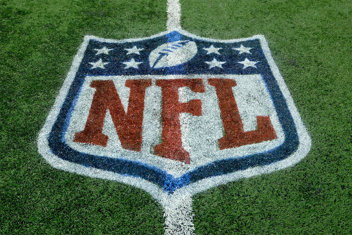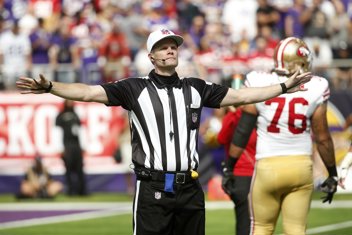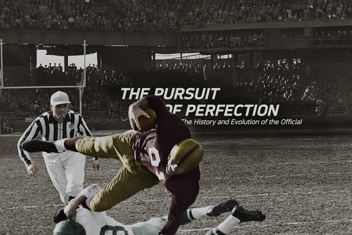Imagine the NFL if the rules of play had never changed:
A quarterback can’t throw a pass unless he’s at least 5 yards behind the line of scrimmage. The offense begins some plays just a yard from the sideline and is penalized for throwing more than one pass during a series of downs. Player substitutions are prohibited. No communication from the sideline is allowed. Players from both teams grab their opponents’ facemasks at will.
Of course, that’s not how professional football is played today. Throughout the history of the NFL, the custodians of the game not only have protected its integrity, but also have revised its playing rules to make the contests fairer, safer and more entertaining. Time and again, the league has shown that it is open to ideas generated by any source or circumstance — or even by new technology — if it believes that the changes will improve the game.
Now spearheaded by the Competition Committee, the NFL rules-changing process is systematic and consensus-oriented. Widely agreed-on ideas may be quickly approved and implemented. Others take years to make it from a proposal to the field. Some evolve over time. And although the vast majority of proposed rule changes are never adopted, all are carefully considered.
The evolution of the league’s kickoff rules shows the process at work.
Between 1974 and 2011, the NFL moved the kickoff line three times. Each adjustment was carefully considered and made solely in response to circumstances and trends at the time.
In 2009, the rules were modified to prevent three or more defensive players from forming a wedge to block for the return man on kickoff returns. This change, aimed at reducing injuries, came about only after the Competition Committee members had meticulously examined hours of film of kickoffs.
Evolving Slowly but Surely
In the league’s early days, the rules-change process evolved slowly. The league that would become the NFL was founded in 1920; it based its rules on the collegiate game and followed those rules for its first 12 years. In 1932, the NFL broke ranks on a few rules and appointed its own Rules Committee, charged with developing changes independent of the colleges; the league would publish its first independent rulebook before the end of the decade.
Today, the Competition Committee — the successor to the Rules Committee — is an nine-member group of team executives and coaches that is the most visible and directly influential source for changes in the game. The committee makes most of the recommendations that are voted on by owners — recommendations that are the culmination of a process, not the extent of it.
"You look and you say, ‘Well, the [Competition] Committee is all powerful.’ Not true. The committee is really a conduit for the game. What is good about the committee is the opportunity to sit in a room and vet ideas over and over again.”
Rich McKay, Competition Committee Chairman
In a 2013 interview with "NFL Total Access"
In the process that it directs and leads, the committee listens to owners, receives recommendations from its Coaches Subcommittee and Player Safety Committee, surveys teams for feedback and suggestions, meets with the players’ union, consults with officials and heeds advice from outside medical experts and the league’s senior vice president of health and safety policy. League experts review injuries, analyze statistics, dissect trends and scrutinize videos of plays and playing situations.
“It’s not just nine people pushing this forward,” said Atlanta Falcons President and CEO Rich McKay, who has been a Competition Committee member for more than 20 years and its chairman since 2011.
Even after a rule is implemented or modified, the committee’s work isn’t done. The NFL reviews a new rule’s impact using statistics, video and input from teams, players and medical advisers to make sure it is having the desired effect.
When the NFL is unsure about a change, it uses the preseason as a testing ground. Instant replay — an essential aspect of the game for most of the past three decades — was initially tested in the 1978 preseason. More recently, in the first two weeks of the 2014 preseason, the NFL tested moving the line of scrimmage for extra-point attempts to the 15-yard line from the 2-yard line to make the success of those attempts less predictable.
For Every Change, A Reason
The impetus for a rules change can come from almost anywhere — controversies over plays or players, unusual circumstances and trends in scoring, injuries and penalties. That’s been true from the league’s earliest days. Its first playoff game in 1932 — a game forced indoors by deep snow and frigid temperatures — inspired one of the most significant rules changes in NFL history.
In that game, Chicago Bears fullback and future Hall of Famer Bronko Nagurski faked a plunge, stepped back, jumped and completed a lob pass to Red Grange for a key touchdown in his team’s 9-0 victory over the Portsmouth (Ohio) Spartans. The Spartans complained bitterly that the play violated a rule stating passes must be thrown from at least 5 yards behind the line of scrimmage.
The controversy contributed to the NFL’s 1933 decision to allow passes from anywhere behind the line — a rules change that legendary Bears owner-coach George Halas said he proposed. That change provided a big lift to the passing attack, which boosted scoring and differentiated NFL play from the college game.
That’s Entertainment
As the rules changes after the 1932 playoff game show, the NFL has championed changes that promote more scoring and more exciting plays.
In the 1930s, leaders of the still-young league wanted to make the professional game more entertaining in the hopes that its popularity would surpass that of college football. By 1940, the NFL had legalized passing from any point behind the line of scrimmage, removed penalties for multiple incomplete passes in the same series of downs, moved hash marks closer to the center of the field and instituted a 15-yard penalty for roughing the passer. It even adjusted the shape of the ball to make it more pass-friendly.
“If someone wants to accuse the National Football League of promoting offense to make the game more exciting, [the committee] believes the league should plead guilty.”
From a 2012 Competition Committee report
“Offensive/Defensive Balance: An Historical Perspective”
In a 1940 report, the Rules Committee stated bluntly: “Each game should provide a maximum of entertainment insofar as it can be controlled by the rules and officials.” The entertainment value of the game, it added, could be measured by “the number of plays per game of a type that will be pleasing to the audience.”
NFL consultant and statistical guru Hugh “Shorty” Ray — enshrined in the Hall of Fame for his contributions to officiating and rule-making — reinforced this notion.
During his work for the NFL from the late 1930s to early 1950s, Ray crunched the numbers and found a direct correlation between scoring and higher attendance — a statistical basis for his recommendations of offense-boosting rules changes. His devotion to statistics as a way to analyze and improve the game also stuck with the league.
Unintended Consequences and Outside Pressures
Flash forward to 1972. In that year, the NFL moved hash marks to their present-day location: 70 feet, 9 inches (about 23.5 yards) from the sidelines, exactly in line with the goal posts. The league wanted to boost offenses by widening the short side of the field, where defenses used the sideline as an extra defender.
It was a natural solution for the league; in the game's initial decades, the use and movement of the hash marks had been critical for adding excitement to the game.
The 1972 change did help the running game — the number of 1,000-yard runners doubled that year, from five to 10, and rushing yards per game climbed. But the overall impact on the offense was not what the NFL intended or desired.
Field goals became easier because the ball now could be placed and kicked from a hash mark aligned with the goal post — a better angle for kickers than the previous location. That placement also meant that teams didn’t have to waste an offensive play trying to move closer to the center of the field for kick attempts.
The shift also hindered the passing game by making it more difficult for quarterbacks to get a pre-snap read on defensive coverage and call an audible to change the play. Because it didn’t have to protect an especially wide side, the defense no longer had to reveal its coverage by committing players to a side before the snap. This enabled coaches to better disguise the coverage and stifle passing attacks.
The hash marks’ new location also helped pass defenses by creating visual markers on the field for the five underneath zones some teams liked to play at the time. In 1972 and 1973, passing yards per game declined.
The announcement in 1973 that a rival professional league — the World Football League — would play its first games the next year put pressure on the NFL, said Pro Football Hall of Fame historian Joe Horrigan. The upstart league sought to attract fans with rules that were friendlier to the offense than the NFL’s.
In 1974, the NFL implemented a package of changes to reinvigorate the game by boosting the passing attack, increasing the opportunity for big plays on kickoff and punt returns, reducing the incentive to kick field goals and minimizing drive-stalling penalties. Some of these proposals had been considered individually for years, but were finally approved as a package “to put the emphasis on scoring touchdowns instead of winning by kicking field goals,” Paul Brown, a Competition Committee member, told Sports Illustrated at the time.
The changes included:
- Moving the goal posts from the goal line to the end line, immediately making every kick 10 yards longer and getting the post out of the way of pass patterns in the end zone.
- Making all field goals missed beyond the 20-yard line result in the other team's taking possession at the line of scrimmage.
- Moving kickoffs from the 40-yard line to the 35-yard line.
- Prohibiting the offensive team on punts from moving downfield until the ball is kicked.
- Reducing penalties on offensive players from 15 yards to 10 for holding, illegal use of hands and tripping. In the interview with Sports Illustrated, Brown cited NFL statistics showing the rarity of an offense recovering from a 15-yard penalty.
- Allowing a receiver to be chucked only once by a given defender after the receiver has gone 3 yards downfield.
The World Football League disbanded midway through its 1975 season.
In 1978, the NFL further freed up receivers with the illegal contact rule, restricting contact beyond 5 yards downfield. And it loosened the interpretations of holding by offensive linemen by giving them permission to extend their arms and open their hands on pass plays. This had the desired effect of opening up the passing game and reducing conservative play calling.
More changes were made in 1994, due largely to statistical trends showing a 22 percent decline in touchdowns and a 14 percent increase in field goals in the previous decade. At the time, half of the league’s teams were averaging fewer than two touchdowns per game.
Striking a Balance
Even though some fans think that rules changes always favor the offense, it’s not true. Many restrictions affect blocking techniques and other offensive tactics. As was noted in a 2012 Competition Committee report, the 1978 illegal contact rule “simply restored the traditional relationship between the receiver and the defender.”
Defenders ran with receivers without contact until the 1960s, when they began using the “bump and run” technique to move receivers off their routes. That technique took advantage of an anomaly in the offensive and defensive pass interference rules: A nonblocking receiver couldn’t initiate contact with the defender from the time the ball was snapped, but the defender could initiate contact anytime before the pass was thrown.
With the illegal contact rule, beyond 5 yards downfield “the defender has the same obligation to avoid contact with the receiver as the receiver has to avoid contact with the defender,” the committee said. “We have never viewed that as favoring the offense.”
Protecting Players,
Preserving the Game
The committee also favored defenses by placing limitations on the chop block — part of its ongoing mission to protect players from injury as much as possible while keeping the game fair, competitive and exciting.
In a chop block, an offensive lineman blocks a defensive lineman high while another offensive player comes in and blocks him low. Offenses used the technique effectively, especially for running plays, but it resulted in knee injuries for defensive linemen.
From 1979 to 1996, the league placed increasingly stricter restrictions on when and who could use the chop block. In 1981, it essentially eliminated the technique for pass plays; in 1996, the NFL made it illegal for all running-play blocks “away from the flow of play” if the two blockers were not lined up next to each other.
That didn’t bring an end to the debate over the chop block; you can still find arguments for and against these restrictions and many other game rules.
Improving and Preserving the Greatest Game
The history and evolution of NFL rules changes is, at its core, a story about the league’s willingness to make any change it believes will benefit the game, its players or its fans as long as it also preserves the game’s integrity. Whether for fairness, safety or entertainment, the NFL remains open to change.
The position of the goal posts on the field illustrates the NFL’s balancing act.
In 1933 the NFL wanted to make field goals easier to reduce the number of tie games, so it moved goal posts from the back of the end zone to the goal line. It worked: The number of field goals doubled, and ties, which occurred in roughly 20 percent of all games played in 1932, dropped to less than 5 percent of games in 1933.
Nearly 40 years later, circumstances had changed: Kickers were now more specialized and field goals had become too easy. By 1973, the three-pointers accounted for nearly a quarter of all scoring. In 1974, the NFL responded by returning the goal posts to the back of the end zone.
Kickers, however, have become so proficient that the long-term impact has been minimal. Whether it’s because of better talent, technique, training or field conditions, more indoor stadiums or other factors, today’s NFL kickers convert field goal attempts in record numbers — more than 86 percent in 2013 — even from longer distances. Field goals regularly account for more than 20 percent of all scoring in a season.
Is there anything the NFL could or should do? How would the game change if the league narrowed the goal posts or moved the hash marks so they don’t line up with the goal posts? Would the game be better off, or worse?
As with every other rules change in its history, the NFL must carefully weigh all of those factors and more before making a change. It’s what the league must do — for the good of the game.



